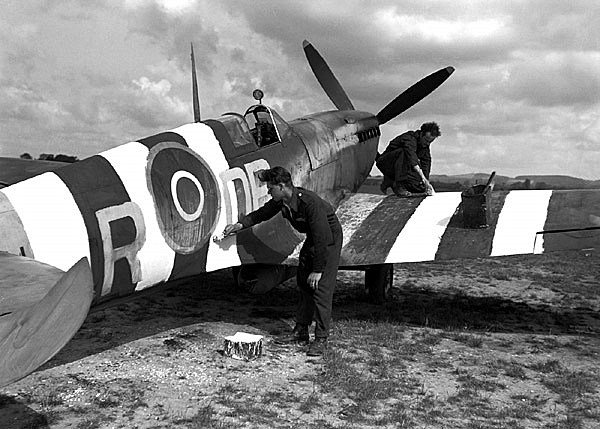357th Fighter Group Aircraft Markings
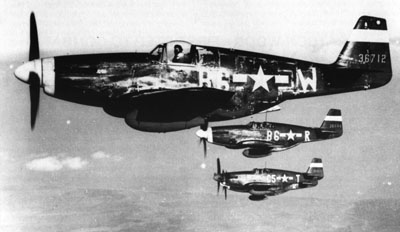
White noses, scarred paint, 75 gallon tanks, all indicators of the very early days. C5-T is Richard Peterson in his first Hurry Home Honey. B6-W is Colonel Graham, one of the first P-51s with the malcolm hoods installed.
The 357th Fighter Group flew only two types of aircraft as basic equipment. Bell P-39D’s were the first, issued while the Group was at Tonopah, and all were “training weary.” Later, P-39L, N and Q models were issued. Paint schemes on P-39s were standard, Olive Drab upper surfaces and Neutral Gray Drab upper surfaces and Neutral Gray lower. After the move to California, blocks of numbers between 100 and 175 were allotted to the three squadrons (362nd had 100 to 125, etc.) These appeared as large white numbers on both sides of the nose.
Early in the training phase, Squadron colors were assigned, White for the 362nd, Red for the 363rd and Yellow for the 364th. These sometimes appeared as painted tail sections, wing tips and a noseband behind the spinner. In many cases, however, the colored noseband was all that was applied.
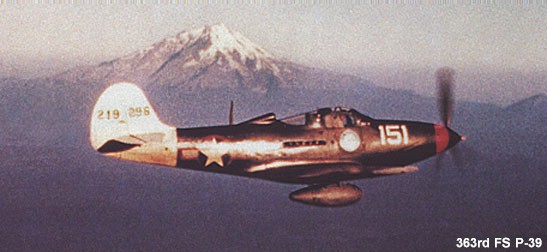
Soon after arrival at Raydon Wood, November 1943, the first Mustangs were assigned, all P-51B models at first. These were painted in the standard of the day, olive drab upper and gray lower. Noses were white back to the forward-most exhaust stack. White identification bands, about 14 inches wide, began to appear inboard on the wings and on the horizontal tail surfaces in mid or late December.
Very soon after the aircraft arrived, the new squadron and individual code letters were applied to the sides of the Mustang’s fuselages. Squadron codes were G4 for the 362nd, B6 for the 363rd, and C5 for the 364th. These codes were in all cases forward of the fuselage national insignia, the individual aircraft letter always being aft of it. In cases where more than 26 planes were assigned to a squadron, or a second plane had the same aircraft letter as another, a bar was added to the letter, above or below: i.e. A or “A bar”. Codes and aircraft letters were in white.
When the Group first entered combat in February 1944, the machines were otherwise unadorned, but this soon changed. As with other AAF fighters of the period, names were applied to many of the P-51s. Not all carried names, but most did, including such planes as “Joan” and “Tangerine”. A few had more elaborate names and drawings, such as “Passion Wagon” with a near life-size nude on her engine cowl.
Group identification markings were assigned late in March 1944 and were applied to all aircraft as fast as the squadron painters could complete the job. The 357th was identified by red-yellow-red bands on the spinner, and two rows of red and yellow checkers aft of the spinner, back to the exhaust stacks.
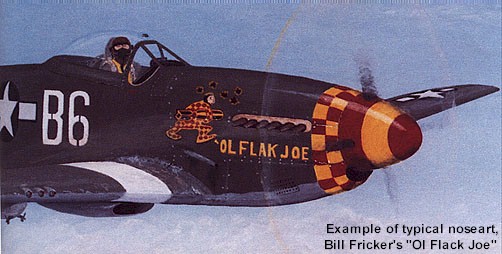
Rudder colors, indicating squadrons, were officially specified by the 8th Air Force in the fall of 1944, and the 357th used the same colors that had been in effect on stateside P-39s. Application of the rudder colors does not appear to have been consistent, however, especially in the 362nd Squadron.
In recent years there has been considerable speculation about the meaning of the small white cross, seen on the left side of P-51s (and P-38s), just below the windshield. There was nothing mysterious about this symbol, which merely indicated the aircraft’s CG (center of gravity).
Black and white Invasion Stripes were applied on the night of June 5, 1944 and were entirely standard, being fully around the fuselage, behind the cockpit, and around each wing, inboard of the national insignia. During July they were removed from the upper surfaces. Their subsequent status is covered by the following Teletype message:
CONFIDENTIAL 8FC A144 EK THE FOLLOWING TELETYPE IS QUOTED FOR YOUR INFORMATION AND COMPLIANCE QUOTE D-68652 AUTH AMENDMENT NO 3 SHAEF OPERATIONS MEMO NO 23. DISTINCTIVE AIRCRAFT MARKINGS 19 AUG 44. DISTINCTIVE BLACK AND WHITE STRIPE MARKINGS PRESCRIBED FOR INVASION WILL BE REMOVED FROM ACFT WINGS. FUSELAGE MARKINGS WILL REMAIN. PERIOD 25 AUG TO 10 SEPT ALLOTTED FOR REMOVAL OF WING MARKINGS. OCCASSIONAL ACFT MAY BE SEEN WITH WING MARKINGS AFTER 10 SEPT DUE TO DIFFICULTIES INCIDENT TO PAINT REMOVAL FROM FABRIC AND WOOD SURFACES WITH DAMAGE TO STRUCTURE SIGNED DOOLITTLE UNQUOTE.
Even so, removal of the wing stripes was an erratic thing, and vestiges of them remained for a long time.
Natural metal finish (NMF) Mustangs began to arrive in the spring of 1944, and on them markings previously applied in white were now applied in black, but this did not mean an end to the camouflaged birds. Beginning in May and on the advice of SHAEF, many newly arriving NMF aircraft were painted with medium green upper and gray lower surfaces. The paint almost surely came from RAF stocks, as did many other items of equipment. This practice continued until the fall of the year, when NMF became standard. Some camouflaged P-51s were still in service in the spring of 1945, however.
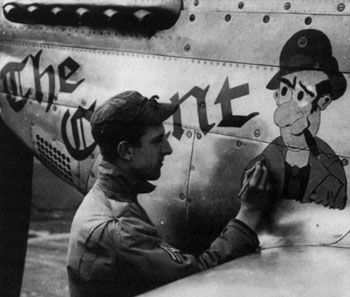
Corporal Horace Wilson, an artistic armorer, finishes the nose art on Carroll Ofsthun’s The Count.
The attrition rate was very high on aircraft. For the period 30 November 1943 through 31 July 1944, 218 P-51s had been assigned, and 139 had been lost. Thirteen of these losses were in crashes, 52 were transferred out for battle damage, and 74 were lost in action. Even so, at war’s end there were still eight old B and C series P-51s left.
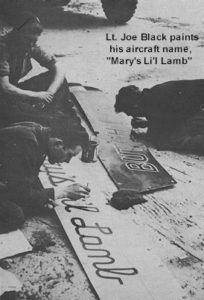
The 357th also had one of the rare two seat P-51B’s, converted from a single sweater by the 469th Service Squadron. The rear seat had the standard canopy, while the normal forward canopy was replaced with a sliding Malcolm hood. With the forward Malcolm hood in the open position, the rear canopy could not be opened. It was named “Eager Beaver” in honor of the commander of the 469th, Capt. Robert Lynch.
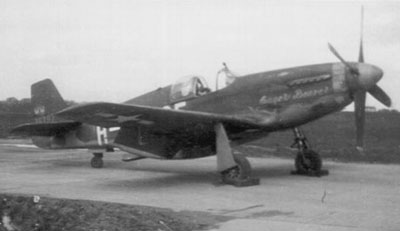
Eager Beaver Thanks to Earl Wassom Collection/466th BGA. Earl took the photo as the plane was parked next to his B-24.
In addition to the main operational type, each squadron had its own hack – a UC-64 Norseman for the 362nd and North American AT-6s for the other two squadrons. Other odd types, such as a Miles Master and an Airspeed Oxford, were on hand for brief periods, and the station gunnery flight used a couple of Vultee Vengeance aircraft to tow targets.
By Merle Olmsted, 357th Fighter Group Association Historian
